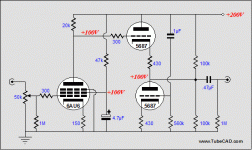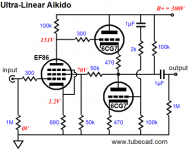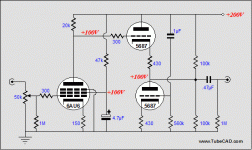Just wondered if anyone has made a 6SJ7/6SN7 Aikido line stage yet. Remembering back to around 2003 John had designed a 6Au6/5687 line stage.
I made one and it sounded great. Yes, some would say too much gain but to repeat it just sounded so good.
This morning sitting here going thru threads I wondered if it was possible to make something a little different. I looked thru the info that was published years back and it listed different tubes and the respective parts and voltages. Not too much if memory is correct has been on the net about single front ends other than the 6Au6 that I can remember.
I was wondering if someone would join in the designing process and help me come up with something.
I made one and it sounded great. Yes, some would say too much gain but to repeat it just sounded so good.
This morning sitting here going thru threads I wondered if it was possible to make something a little different. I looked thru the info that was published years back and it listed different tubes and the respective parts and voltages. Not too much if memory is correct has been on the net about single front ends other than the 6Au6 that I can remember.
I was wondering if someone would join in the designing process and help me come up with something.
Just a simple line stage like John Broskie designed back in 2003 using a 6AU6 and a 5687 per channel. I thought since I have a bunch of 6SJ7's and 6SN7's maybe it could be done with them.
I'd like to do something like this only with a 6SJ7 and 6SN7 instead of the 6AU6 and 5687.
I'd like to do something like this only with a 6SJ7 and 6SN7 instead of the 6AU6 and 5687.
Attachments
Last edited:
The potential problem that I see in all 3 schematics:
A capacitor is used to couple B+ ripple voltage onto the grid of the bottom tube in the 2nd stage.
. . . What?
Is this an attempt at a hum cancelling scheme?
Whatever it is, copying one schematic again and again into another schematic with different parts gives the same results.
If you want to cancel the hum that way, the resistive dividers and capacitor value have to be individually set, depending on the circuit parameters, and the tube's individual parameters.
And that divider adjustment can only Either be set for 2X power mains frequency, Or 1X power mains frequency,
because capacitive reactance is 2:1 for frequencies that are 2:1. The division ratio changes with frequency.
If it is not a hum cancellation scheme, take that capacitor out of the circuit;
Or simply connect that cap from the bottom tube grid, and the other end of that cap to ground.
Do not connect the capacitor to B+ because . . .
B+ is a noisy, and hum laden form of AC ground.
Ground is quieter, especially if you took care to keep all the ground loops of the preamp at a minimum.
Those ground loops include the B+ local ground loop, and the input circuit local ground loop, but there can be other ground loops as well.
"Grounds are Commonly Misunderstood" - Me
A capacitor is used to couple B+ ripple voltage onto the grid of the bottom tube in the 2nd stage.
. . . What?
Is this an attempt at a hum cancelling scheme?
Whatever it is, copying one schematic again and again into another schematic with different parts gives the same results.
If you want to cancel the hum that way, the resistive dividers and capacitor value have to be individually set, depending on the circuit parameters, and the tube's individual parameters.
And that divider adjustment can only Either be set for 2X power mains frequency, Or 1X power mains frequency,
because capacitive reactance is 2:1 for frequencies that are 2:1. The division ratio changes with frequency.
If it is not a hum cancellation scheme, take that capacitor out of the circuit;
Or simply connect that cap from the bottom tube grid, and the other end of that cap to ground.
Do not connect the capacitor to B+ because . . .
B+ is a noisy, and hum laden form of AC ground.
Ground is quieter, especially if you took care to keep all the ground loops of the preamp at a minimum.
Those ground loops include the B+ local ground loop, and the input circuit local ground loop, but there can be other ground loops as well.
"Grounds are Commonly Misunderstood" - Me
Last edited:
Much depends on where you intend the first stage plate voltage to land. Assuming you aim for about 1/2 of the B+ and that leaves half the B+ for each half of the 6SN7, that's about 10mA of current.
Yup 10 mA on the 6SN7's. The beauty of the Aikido is being able to substitute different tubes and of course they require different resistors and such. Unfortunately Broskie only did the 6Au6 in combination with the 5687 tube. I'm confident that the second tube (6SN7) will work with the components I listed to maintain the 10mA and the noise reduction. Unfortunately I cannot clearly see the load lines and don't to be blunt have experience with pentodes. This is why I hope someone can lend some assistance.
The potential problem that I see in all 3 schematics:
A capacitor is used to couple B+ ripple voltage onto the grid of the bottom tube in the 2nd stage.
. . . What?
Is this an attempt at a hum cancelling scheme?
Whatever it is, copying one schematic again and again into another schematic with different parts gives the same results.
If you want to cancel the ground that way, the resistive dividers have to be individually set, depending on the circuit parameters, and the tube's individual parameters.
And that divider adjustment can only be set for 2X power mains frequency, or 1X power mains frequency, because capacitive reactance is 2:1 for frequencies that are 2:1.
If it is not a hum cancellation scheme, take that capacitor out of the circuit;
Or simply connect that cap from the bottom tube grid, and the other end of that cap to ground.
Because . . .
B+ is a noisy, and hum laden form of AC ground.
Ground is quieter, especially if you took care to keep all the ground loops of the preamp at a minimum.
Those ground loops include the B+ local ground loop, and the input circuit local ground loop, but there can be other ground loops as well.
"Grounds are Commonly Misunderstood" - Me
I think there is a chart that gives the Aikido component values with consideration to the gain, current, and B+. Basically it gives one the ability to select the first tube and the second to to tailor the circuit to your needs and ears. Unfortunately, there isn't anything except the 6Au6 as the single input tube. Great sounding by the way with the 6Au6/5687 combo. I built one years ago and it never got finished and the parts went back into the parts bin.
A capacitor is used to couple B+ ripple voltage onto the grid of the bottom tube in the 2nd stage.
. . . What?
Is this an attempt at a hum cancelling scheme?
Yes, this is the principle feature of John Broskie's Aikido design:
New Tube Circuit: The Aikido Amplifier
I re-edited my post, changed the words "cancel the ground that way", to
"cancel the hum that way".
Did you understand that hum and noise on B+ will be coupled to the bottom tube, and so that hum and noise also will be passed on to the output of the preamp.
I am sorry if I did not make that fact clear, and easy to understand.
Hum and noise cancellation techniques always work at the beginning, after the adjustments are made.
As soon as a tube starts to age, the hum and noise comes back.
Your mileage Will vary.
"cancel the hum that way".
Did you understand that hum and noise on B+ will be coupled to the bottom tube, and so that hum and noise also will be passed on to the output of the preamp.
I am sorry if I did not make that fact clear, and easy to understand.
Hum and noise cancellation techniques always work at the beginning, after the adjustments are made.
As soon as a tube starts to age, the hum and noise comes back.
Your mileage Will vary.
Last edited:
Yes, this is the principle feature of John Broskie's Aikido design:
New Tube Circuit: The Aikido Amplifier
Yes. Hum canceling main principle of John's Aikido design. Years ago diyaudo had some Aikido boards and power supply boards made before John started manufacturing them.
I re-edited my post, changed the words "cancel the ground that way", to
"cancel the hum that way".
Did you understand that hum and noise on B+ will be coupled to the bottom tube, and so that hum and noise also will be passed on to the output of the preamp.
I am sorry if I did not make that fact clear, and easy to understand.
Hum and noise cancellation techniques always work at the beginning, after the adjustments are made.
As soon as a tube starts to age, the hum and noise comes back.
Your mileage Will vary.
Actually I put together a line stage from the diyaudio boards and power supply board. That was many years ago. The design featured a variable resistor to keep the hum nulled. As a matter of fact I adjusted mine today and its absolutely dead quiet.
Thanks!
Now I finally understand why John Broskie's Aikido preamp gets mentioned in so many threads.
I design and build non-fedback single ended and push pull amplifiers.
Well some do have some negative feedback in the form of UL operation (UL is negative feedback).
They have 100uV or less hum and noise at the amplifier output.
A preamp is different, lower hum and noise levels are required.
But the B+ currents are far less in a preamp than they are in a power amp,
So, it is far easier to get lower levels of hum and noise in the preamp's B+.
And in that case, cancelling techniques are not required.
The issue is the 2 directions taken by 2 different engineers,
Kill hum and noise.
Cancel hum and noise.
Choose one.
"Every engineering problem has at least 100 solutions, of which at least 3 solutions will work, but only if the solutions are implemented properly" - Me
Now I finally understand why John Broskie's Aikido preamp gets mentioned in so many threads.
I design and build non-fedback single ended and push pull amplifiers.
Well some do have some negative feedback in the form of UL operation (UL is negative feedback).
They have 100uV or less hum and noise at the amplifier output.
A preamp is different, lower hum and noise levels are required.
But the B+ currents are far less in a preamp than they are in a power amp,
So, it is far easier to get lower levels of hum and noise in the preamp's B+.
And in that case, cancelling techniques are not required.
The issue is the 2 directions taken by 2 different engineers,
Kill hum and noise.
Cancel hum and noise.
Choose one.
"Every engineering problem has at least 100 solutions, of which at least 3 solutions will work, but only if the solutions are implemented properly" - Me
Last edited:
OK, so we'll assume that you want to use a 20K plate load and end up with about half the B+ voltage on the plate of the 6SJ7 so the 6SN7s are happy. That is 100V across 20K, so 5mA of current.
We can do that with 145V on the screen and 4.35V of bias. Screen current is 1.57mA, and going from 200V to 145V at 1.57mA means a screen dropping resistor of 35K. 5mA of plate current and 1.57mA of screen current flow through the cathode resistor to make 4.35V of bias, so that cathode resistor should be 662 ohms. I don't have the spreadsheet on this computer that calculates the adjusted gm for no bypass cap across the cathode resistor, but ultimately the gain will be pretty low. I think this is a good thing.
If the resistor values that you can get aren't exactly what I specified (like the 662 ohm resistor), just get the closest value.
We can do that with 145V on the screen and 4.35V of bias. Screen current is 1.57mA, and going from 200V to 145V at 1.57mA means a screen dropping resistor of 35K. 5mA of plate current and 1.57mA of screen current flow through the cathode resistor to make 4.35V of bias, so that cathode resistor should be 662 ohms. I don't have the spreadsheet on this computer that calculates the adjusted gm for no bypass cap across the cathode resistor, but ultimately the gain will be pretty low. I think this is a good thing.
If the resistor values that you can get aren't exactly what I specified (like the 662 ohm resistor), just get the closest value.
- Status
- This old topic is closed. If you want to reopen this topic, contact a moderator using the "Report Post" button.
- Home
- Amplifiers
- Tubes / Valves
- Aikido 6SJ7/6SN7?


